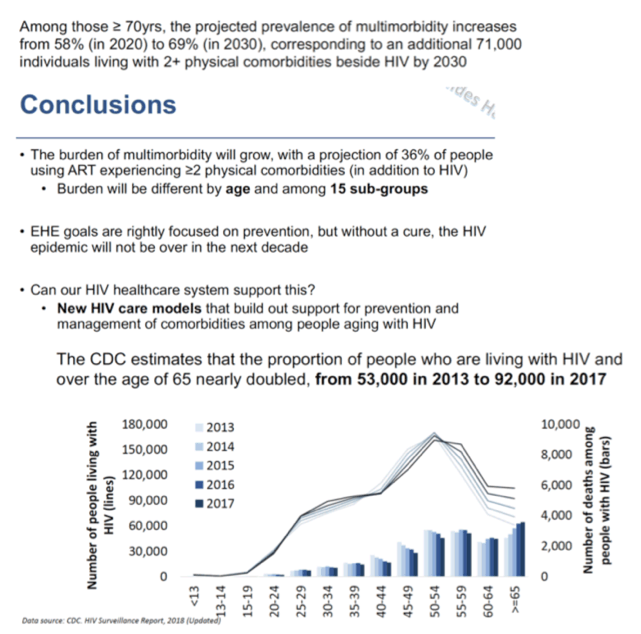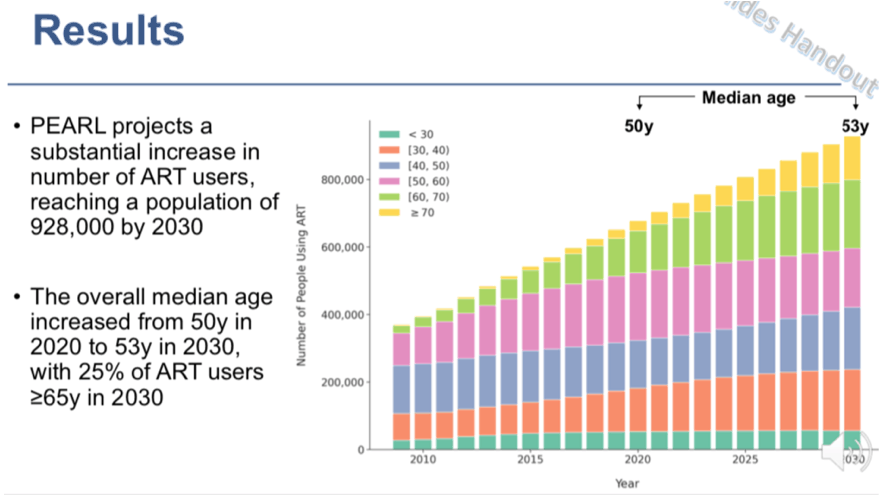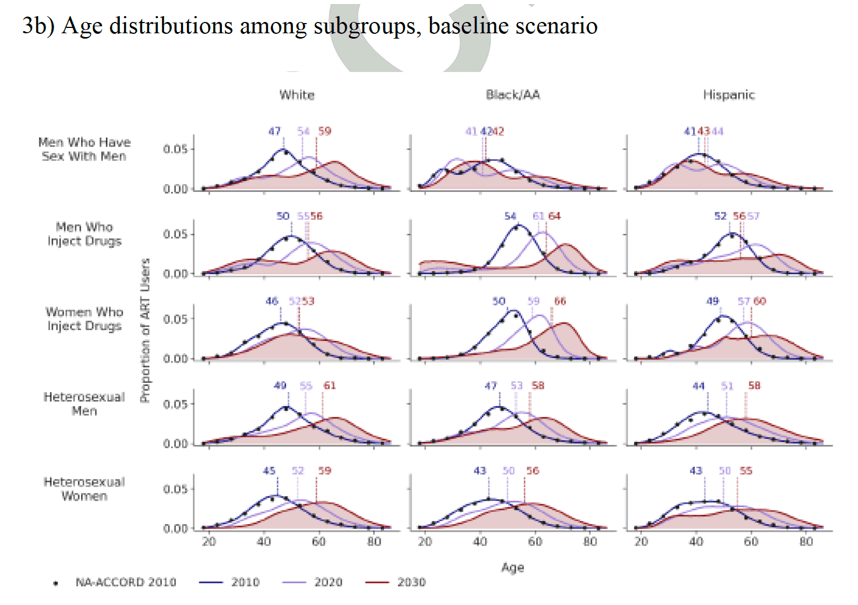| |
The shifting age distribution of people with HIV using antiretroviral therapy in the United States, 2020 to 2030
|
| |
| |
Download the PDF here
AIDS Nov 8 2021 - Keri N Althoff, PhD, MPH1, Cameron N Stewart, M.Sc.1, Elizabeth Humes, MPH, Jinbing Zhang, MS1,Lucas Gerace, BA1, Cynthia M Boyd, MD, MPH2, Cherise Wong, PhD, ScM3, Amy C Justice, MD, PhD4, Kelly Gebo, MD, MPH2, Jennifer E Thorne, MD, PhD1, Anna A Rubtsova, PhD, MA, MsC5, Michael A. Horberg, MD, MAS6, Michael J Silverberg, PhD, MPH7, Sean X Leng, MD, PhD2, Peter F. Rebeiro, MHS, PhD8, Richard D Moore, MD,MHS2, Kate Buchacz9, and Parastu Kasaie, PhD1
Under the baseline scenario, PEARL projects a substantial increase in number of ART-users over time, reaching a population of 909,638 [95%uncertaintyrange(UR):878,449-946,513] by 2030. The overall median age increased from 50 years (y) in 2020 to 52y in 2030, with 23% of ART-users age ≥65y in 2030. Under the EHE75% scenario, the projected number of ART-users was 718,348 [703,044-737,817] (median age=56y) in 2030, with a 70% relative reduction in ART-users <30y and a 4% relative reduction in ART-users age ≥65y compared to baseline, and persistent heterogeneities in projected numbers by sex-and-HIV acquisition risk group and race/ethnicity. Autrs project in 2030 34% will be over 60 years old.
AUTHORS SAY:
"It is critical to prepare and
strengthen HIV care systems to meet the needs of the changing epidemic, including strategies
for........prevention and care for comorbid conditions that will likely grow in burden among this aging population."
Adults aging with HIV experience a high burden of age-related comorbidities, which
may be reduced with comorbidity prevention and treatment interventions.20-26 Existing
heterogeneities in burden of type-specific comorbidities by race/ethnicity suggest the need for
tailoring of existing interventions. For example, preventing hypertension in Black/AA men
with HIV, who have high rates of hypertension, may result in a greater reduction in overall
comorbidity burden as compared to the same interventions in non-Black women, who have
lower rates of hypertension.27 The difference in our projected age distributions of ART-users
by sex, HIV acquisition risk and race/ethnicity over the next decade further suggests the need
for tailoring future comorbidity prevention programs to the needs of specific subgroups,
ensuring the most effective intervention meets the most appropriate subgroup at the right
time.28 Significant challenges exist to bolster the current HIV workforce to meet the growing
needs of populations aging with HIV who require further expertise to manage
multimorbidity.29,30 In terms of cost, the projected increase in number of ART-users to >900K
by 2030 will likely result in a substantial increase in national spending on ART (estimated at
$420,285 life time discounted costs in 2019 or $22.5 billion annual undiscounted in 2018)
and additional costs associated with treating HIV comorbidities and preventing falls and
frailty.31-33 New interventions aiming to increase the effectiveness of comorbidity prevention among PWH are likely to be cost-effective (and even cost-saving) over the next decade.
The Ending the HIV Epidemic goal to reduce the number of new HIV diagnoses by
75% to 2025 is an ambitious, but a much-needed target to reduce the long-term burden of
HIV in the US. However, without a cure, the HIV epidemic will sustain among populations
infected with HIV for decades to come. Our modeling results suggest that without a
substantial decrease in HIV incidence, a gradual increase in number of ART-users to >900K
by 2030. Along with projected increase in median age of ART-users, these individuals are
likely to experience an increased burden of comorbidities. It is critical to prepare and
strengthen HIV care systems to meet the needs of the changing epidemic, including strategies
for long-term viral suppression, ensuring uninterrupted access to ART and prevention and
care for comorbid conditions that will likely grow in burden among this aging population.
-----------------------------------------
This publication is the followup from the CROI 2021 presentation:
Aging "Silver Tsunami" Predicted - CROI: Multimorbidity in people with HIV using ART in the US: Projections to 2030 - (03/08/21)
The researchers forecast a "silver tsunami" in multimorbidity, polypharmacy, and healthcare costs in US residents with HIV [3]. They suggested the US healthcare system will have to adapt quickly to this mounting multimorbidity burden, aiming especially to prevent and manage comorbidities in aging people with HIV.
The largest increase in number of cases of mutimorbidty will be in MSM, the highest increase in prevalence will be in heterosexual women [24%] & men who inject drugs [17%]. More than one third of US residents with HIV will have multimorbidity (2 or more non-HIV comorbidities) by 2030, according to a modeling analysis in a group simulating the 15- to 85-year-old US population treated with antiretroviral therapy (ART) [1]. Researchers predicted greater jumps in comorbidity rates among certain subgroups, including older age cohorts, Hispanic men who inject drugs, and Hispanic women. Defining multimorbidity as having 2 or more physical comorbidities in addition to HIV, the PEARL team determined that 30% of the US HIV population had multimorbidity in 2020. The model projects that fraction will rise to 36% in 2030. By HIV acquisition risk, PEARL predicts that the biggest jump in number of people with multimorbidity from 2020 to 2030 will come among men who have sex with men (MSM), with gains spurting from 21,000 additional cases among Hispanic MSM to 34,000 additional cases among black MSM. The model forecasts that Hispanics will endure two of the largest flares in multimorbidity from 2010 to 2030: 17% among men who inject drugs and 24% among heterosexual women.



AIDS Nov 8 2021
Abstract
Objective:
To project the future age distribution of people with HIV using antiretroviral therapy (ART) in the US, under expected trends in HIV diagnosis and survival (baseline scenario) and achieving the Ending the HIV Epidemic (EHE) goals of a 75% reduction in HIV diagnoses from 2020-25 and sustaining levels to 2030 (EHE75% scenario).
Design:
An agent-based simulation model with mathematical functions estimated from North American AIDS Cohort Collaboration on Research and Design data and parameters from the US Centers for Disease Control and Prevention's annual HIV surveillance reports.
Methods:
The PEARL (ProjEcting Age, multimoRbidity, and poLypharmacy in adults with HIV) model simulated individuals in 15 subgroups of sex-and-HIV acquisition risk and race/ethnicity. Simulation outcomes from the baseline scenario are compared with outcomes from the EHE75% scenario.
Results:
Under the baseline scenario, PEARL projects a substantial increase in number of ART-users over time, reaching a population of 909,638 [95%uncertaintyrange(UR):878,449-946,513] by 2030. The overall median age increased from 50 years (y) in 2020 to 52y in 2030, with 23% of ART-users age ≥65y in 2030. Under the EHE75% scenario, the projected number of ART-users was 718,348 [703,044-737,817] (median age=56y) in 2030, with a 70% relative reduction in ART-users <30y and a 4% relative reduction in ART-users age ≥65y compared to baseline, and persistent heterogeneities in projected numbers by sex-and-HIV acquisition risk group and race/ethnicity.
Conclusions:
It is critical to prepare healthcare systems to meet the impending demand of the US population aging with HIV.

|
|
| |
| |
|
|
|